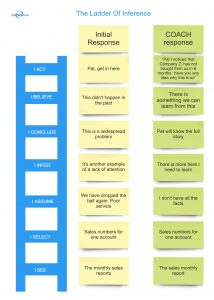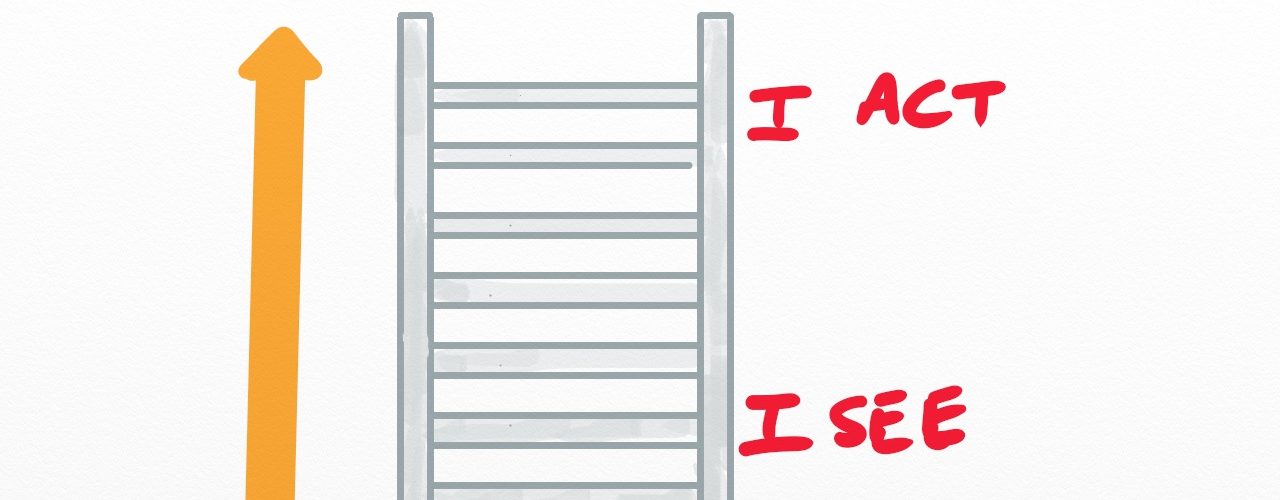Feedback And The Ladder Of Inference
The Ladder of Inference is a formidable tool in any sales leaders toolbox. Too often feedback conversations become emotional. Feedback sessions lose impact when emotions control the narrative.
Organisational psychologist Chris Argyris first conceived it, and Peter Senge refers to it in his brilliant book The Fifth Discipline. Many other authors and writers have used different variations of the same. I have found the simplicity of the Ladder of Inference offers its greatest power. But, first, let’s look at how so many day-to-day feedback conversations can go off track.
The Ladder of Inference in Action;
John is Managing Director of a €5m business that provided IT support for Blue Chip clients in Ireland and the UK.
John was checking his monthly management reports and noticed that a client he had opened many years ago when he was in sales, hadn’t renewed their IT management support in 6 months. John was livid.
He immediately called for the sales manager. He had had some doubts about his Sales Manager for some time now, and now he was ready to give him a piece of his mind.
To John, it was just another example how we ignore a great client. Another lost client due to poor service and a lack of attention to detail in meeting client’s needs. He had serviced that client for years and in his view, they were a “keeper”. They were a life-long client. Someone must have done something wrong. Someone must have let them down.
By the time Pat the Sales Manager had arrived, John had already concluded that it was a widespread problem. He remembered the loss of another large client two years ago. That was all down to poor service, and poor communication. He held firm beliefs about service levels and client communication.
When Pat entered the room, he had barely time to sit down, when John launched into a verbal assault.
“One of our best customers, lost? Another one lost? And what are you doing about it? What the hell is going on with the sales team? Who is monitoring performance? What do I have to do to ensure stuff gets done in this business”?
Pat was shell-shocked, although John did have a reputation as a hothead. What client was John referring to? When it became clear, he said “oh that client, yes that’s a sad story, isn’t it. They closed down six months ago, after 22 years in business. But the good news was that they cleared their account in full.”
Oh dear… does this sound familiar to you?

Using The Ladder Of Inference in giving feedback;
In sales leadership, feedback is critical to developing and growing your team. But feedback needs to be based on facts. As much as possible you need to remove the emotion from your conversations.
If you have not read my other article How To Use Science To Help You Build Trust, When Selling, I suggest you take five minutes now and do just that.
Your brain can often work against you in sales leadership feedback conversations. To fully CONNECT with your team, you need to build a foundation of trust. You need to consciously open up conversations to allow the Prefrontal Cortex (PFC), the executive part of your brain to take over. When this happens, your brain floods the body with positive chemicals such as dopamine, serotonin, and oxytocin. All contribute to building high-trust conversations.
The natural inclination of your brain in a “feedback” conversation is to activate the Amygdala, “your danger sentinel”. You need to avoid this happening. The result of amygdala becoming highly active is that conversations close down. Fear takes over, and emotions drive often-irrational responses. Distrust builds and the potential for a breakdown in communication rises.
In many ways, the Ladder of Inference tracks the steps you may take that lead you to “jump to conclusions”, and take actions that ultimately lead to situations you may regret. It maps out what is happening in your brain, and can help you identify where your leadership conversations may be going astray.
The rungs of the ladder are similar to the way the brain “jumps to conclusions”. Many of the steps are unconscious. The ladder of inference is a beneficial tool to bring the process into your consciousness.
What’s the goal?
As a sales leader, your goal is to stay at level one on the ladder. Stick to the facts. By doing so, you avoid the possibility of bringing your emotions and beliefs to the table.
Let’s see how this works.

Let’s replay the scene using the Ladder of Inference;
Step One – I See.
By staying at factual level (What I see is), John could have avoided potential conflict.
John could have avoided this by asking a question based on facts.
“Pat I noticed (I SEE) that Company Z, has not bought from us in 6 months. Have you any idea why this is so”?
Remember when you remove the emotion from the leadership conversation you enable trust. Activating the Prefrontal Cortex, builds trust and opens up the conversation. When you reflect what you see, or what you heard, rather than your filtered view of what you saw and heard, you ensure that the conversation is “trust” centred.
Step Two – I Select.
John selected facts from what he read. And he immediately moved up the ladder.
The Limbic system is your emotional centre. It is the centre for your memories also. As your brain is a mapping tool, it uses the limbic system to map out memories. Buried within the maps are information from all of your senses, taste, smell etc.
For example, if I ask you to imagine yourself going to your white fridge, and opening it. Then go to the fruit drawer in your fridge and take out a juicy orange. Now cut the orange open with a knife and take a bite. Feel that juicy, tangy sensation as you bite into the orange. Feel how cold it is against your tongue. Smell that citrus and savour the moment.
Just by imagining you are eating an orange you activate senses throughout your brain and body. You may not have noticed, but you have salivated. You may have experienced the smells, and you probably had a clear picture of the orange as you cut through it.
Your Limbic System and your hippocampus generate these reactions. So too with other experiences. Your brain references older memories in the Limbic System and brings them to the fore.
For John this was not necessarily a positive thing. He selected a piece of information resulting in an emotional replay of an old “movie”. With this old “movie” came the mental map and its emotional attachments. This response may not be appropriate.
Step Three – I Assume.
John then interpreted the “selected reality” as an issue with the sales manager and/or team.
His “mental movie” based on previous experiences became the new reality for today’s incident. The mental map brings with it all of the emotions and memories that were relevant previously. They may not be relevant now. This new selected reality leads John on the offensive, and to the next step on the ladder.
Step Four – I Infer.
John quickly inferred that the problem was down to poor service and/or poor communication amongst the team.
Based on previous experiences, John reacted. If it looks like a poor service issue, smells like a poor service issue, then it must be a poor service issue.
But, John didn’t have all of the facts. Nonetheless once activated the Amygdala kicks in flooding John’s system with adrenaline, cortisol and norepinephrine. All serve to “hijack” the executive thinking part of his brain. He is now on auto-pilot, and the setting is a fight, flight or freeze. He selects fight.
Step Five – I Conclude.
John quickly concluded that he needed to sort the problem out, as nobody else seemed competent enough to do so. John concluded incorrectly, but he is unaware of the subconscious activities in his brain. At this stage, his brain is moving from trust to distrust rapidly. Adrenaline pushes up the heartbeat. Cortisol is an active stress hormone, so he is feeling more aggressive, and tenser.
Step Six – I believe.
John’s hardwired beliefs about customer service and communication, helped him form the opinion that there was something major going on. He uses his internal system of mapping to compare his beliefs with what his new “mental movie”. Beliefs are strongly held and evoke strong emotional reactions. John feels compelled to action.
Step Seven – I Act.
John acted. He called the meeting, and he launched straight into a verbal attack. The potential for a bad conversation was obvious, but he was completely unaware of his emotional response, and it impacted his behaviour.
Key Takeaway
The Ladder of Inference helps you understand how your “emotional brain” can hijack sales leadership conversations. When feedback conversations are highly-charged with emotions, they often fail.
When you focus on the FACTS, the bottom rung of the ladder, you can eliminate responses and transform the quality of your feedback sessions.
Regards Ronan
Call me on +353(86) 7732201
Ronan Kilroy | Insthinktive Sales Leadership Ltd. | Blanchardstown, | Dublin 15, | Office 01 8220523
More Sales, More Consistently, In Less Time



